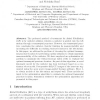Free Online Productivity Tools
i2Speak
i2Symbol
i2OCR
iTex2Img
iWeb2Print
iWeb2Shot
i2Type
iPdf2Split
iPdf2Merge
i2Bopomofo
i2Arabic
i2Style
i2Image
i2PDF
iLatex2Rtf
Sci2ools
MICCAI
2009
Springer
2009
Springer
Optimal Transseptal Puncture Location for Robot-Assisted Left Atrial Catheter Ablation
The preferred method of treatment for Atrial Fibrillation (AF) is by catheter ablation wherein a catheter is guided into the left atrium through a transseptal puncture. However, the transseptal puncture constrains the catheter, thereby limiting its maneuverability and increasing the difficulty in reaching various locations in the left atrium. In this paper, we address the problem of choosing the optimal transseptal puncture location for performing cardiac ablation to obtain maximum maneuverability of the catheter. We have employed an optimization algorithm to maximize the Global Isotropy Index (GII) to evaluate the optimal transseptal puncture location. As part of this algorithm, a novel kinematic model for the catheter has been developed based on a continuum robot model. Preoperative MR/CT images of the heart are segmented using the open source image-guided therapy software, Slicer 3, to obtain models of the left atrium and septal wall. These models are input to the optimization algor...
Catheter Ablation | Medical Imaging | MICCAI 2009 | Optimal Transseptal Puncture | Transseptal Puncture Location |
| Added | 06 Nov 2009 |
| Updated | 15 Nov 2009 |
| Type | Conference |
| Year | 2009 |
| Where | MICCAI |
| Authors | Jagadeesan Jayender, Rajni V. Patel, Gregory F. Michaud, Nobuhiko Hata |
Comments (0)

